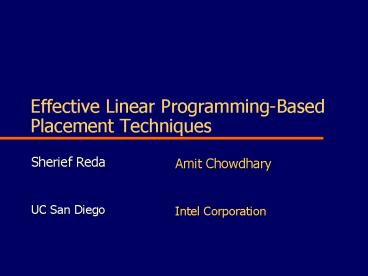Effective Linear ProgrammingBased Placement Techniques - PowerPoint PPT Presentation
1 / 27
Title:
Effective Linear ProgrammingBased Placement Techniques
Description:
Linear programming has been shown to be effective in modeling timing objective during placement ... Efficient modeling of timing and wirelength ... – PowerPoint PPT presentation
Number of Views:44
Avg rating:3.0/5.0
Title: Effective Linear ProgrammingBased Placement Techniques
1
Effective Linear Programming-Based Placement
Techniques
- Sherief Reda
- UC San Diego
Amit Chowdhary Intel Corporation
2
Outline
- Motivation
- Modeling of cell spreading
- Linear programming (LP)-based placer
- Applications of LP-based placer
- Experimental results
- Conclusions
3
Motivation
- Linear programming has been shown to be effective
in modeling timing objective during placement - Static timing can be modeled as linear
constraints using the notion of differential
timing DAC 2005 - Linear programming can effectively model
wirelength as half-perimeter wirelength (HPWL) - Cell spreading not modeled in linear programming
yet - LP has been restricted to incremental placement
4
Main Contribution
- In this paper, we model cell spreading using
linear constraints - Designed a global placer based on linear
programming - Efficient modeling of timing and wirelength
- Uses relative placement constraints to spread
cells gradually - Our LP-based placement approach can be used as
- Global placer
- Whitespace allocator (WSA)
5
LP-based Placement Approach
- Place cells using an ideal or exact HPWL model of
wirelength - Use this initial placement to establish a
relative ordering of cells - Transform relative order of cells into linear
constraints - Solve the corresponding LP problem to spread
cells while maintaining relative order - Iterate till cells are spread out
6
LP-based Placement Approach
Placement after iteration 1
Initial WL-optimal placement
7
Modeling of wirelength
- leftx, rightx, lowery and uppery variables
defined for every net - HPWL model of wirelength used
- For every cell at location (x,y) connected to
net - Length of this net is
8
Lower bound on wirelength
- Length of a net has a lower bound based on the
area of cells connected to it - Lower bound on each net spreads out cells
- Helps in defining relative order of cells
- Overall wirelength objective is
9
Modeling of timing
- Various aspects of static timing analysis can be
formulated as linear constraints of cell
placements DAC2005 - Delay and transition time for cells
- Delay and transition time for nets
- Propagated arrival times
- Slack at cell pins
- Timing metrics
- worst negative slack WNS
- total negative slack TNS
10
Defining relative order
- For each cell v, define four sets corresponding
to the cells to the left, right, upper, and below
v - Quadratic time and space complexity
- Reduce space complexity to linear using
transitivity - Still quadratic time
- We use fast heuristic methods that capture a good
amount of the relative order relationships - Q-adjacency graph
- Delaunay triangulation
11
Q-adjacency Graph
- Simple Idea Establish an adjacency between each
cell and its closest cell in each of the four
quadrant - Complexity is O(M.logM k.M), where k is a
constant that depends on the input placement
12
Delaunay Triangulation
- Capture adjacency using Delaunay triangulation
Delaunay triangulation (dual of the Voronoi
diagram)
Voronoi diagram
- Voronoi diagram
- Partitioning of a plane with n points into
convex polygons such that each polygon contains
exactly one generating point and every point in a
given polygon is closer to its generating point
than to any other point
13
Example of Delaunay and Q-Adjacency
- We use relative order from Q-Adjacency as well as
Delaunay triangulation
14
LP Modeling of Relative Order
For each adjacency u, v
1. if u and v overlap in the current placement
then next separation current separation
minimum additional separation to remove the
overlap and make sure u and v
relative positions stay the same
- make sure the amount of overlap reduces
2. if u and v do not overlap
- make sure a non-overlap does not turn into an
overlap
15
LP-Based Placement Techniques
- Our LP-based placement approach can be used in
several ways - Wirelength-driven global placement
- Whitespace allocation
- Timing- and wirelength-driven global placement
16
1. Wirelength-driven Global Placement
17
Benchmark statistics
- Circuits chosen from a recent microprocessor
18
Comparison with Other Placers
- Compared results with other placers
- Capo 9.3 (UMich)
- Better of FengShui 2.6 and 5.1 (SUNY)
- APlace 2.0 (UCSD)
- Better of mPL 4.1 and 5.0 (UCLA)
- All placements were measured using the same HPWL
calculator
19
Results of comparison
20
Comparison of Placers
21
Placements of different placers
mPL5.0
APlace2.0
Our Placement
HPWL 881
HPWL 802
FengShui5.1
Capo9.3
HPWL 804
HPWL 891
HPWL 823
22
2. Whitespace Allocation
- In an existing legal placement, we redistribute
white space to optimize wirelength
Unplaced circuit
Global Placement Legalization
MidX Whitespace Allocation
Legalization
Detailed Placement
Final Placement
23
Whitespace Allocation Example
24
3. Timing-driven global placement
25
Timing-driven global placement
- Start with a timing-optimal relaxed placement
obtained using our differential timing-based
placer DAC 2005 - Identify timing critical cells from a static
timer - Spread cells using MidXT with a combined
objective of - Minimize total wirelength of all nets
- Minimize total displacement of all
timing-critical cells - We are working on integrating the static timing
constraints in MidXT placer
26
Timing-driven placement Example
Input Placement TNS -13.99
Relaxed placement TNS -8.82
27
Conclusions
- Extended LP-based placement approach to model
cell spreading - Relative order amongst adjacent cells are
transformed into linear constraints - Presented a powerful LP-based global placer
- Gradually spreads cells while maintaining
relative order - Benchmarked against academic placers
- Models timing and wirelength very accurately































